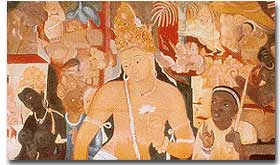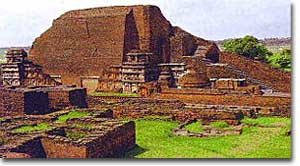8e. The Gupta Period of India

The Ajanta and Ellora caves were created during the Golden Age. They were decorated with paintings of religious figures; some Hindu and some Buddhist.
The Gupta Period of India was not characterized by enormous material wealth or by elaborate trade activity.
It was defined by creativity. Flourishing arts, fabulous literature, and stupendous scholars are just a few of the things that marked the period.
In 185 B.C.E., the Mauryan empire collapsed when the last of the Mauryan kings was assassinated. In its place, small kingdoms arose throughout India.
For nearly 500 years, the various states warred with each other. In the northern territories, a new empire arose when a ruler named Chandragupta I ascended the throne in 320 C.E. He revived many principles of Mauryan government and paved the way for his son, Samudragupta, to develop an extensive empire.
Victory at Any Cost
Samudragupta was a great warrior and conquest was his passion. He sought to unite all of India under his rule and quickly set out to achieve this goal by waging wars across much of the Indian subcontinent.
Hoping for mercy, many potential victims offered tribute and presents to Samudragupta as he swept through the territories. But little mercy was granted. One by one, he defeated nine kings in the north and twelve in the south. In addition to the human devastation countless horses were slaughtered to celebrate his victories.
The Gupta territories expanded so greatly under Samudragupta's reign that he has often been compared to great conquerors such as Alexander the Great and Napoleon. But of course he did not achieve military success singlehandedly. Local squads — which each consisted of one elephant, one chariot, three armed cavalrymen, and five foot soldiers — protected Gupta villages from raids and revolts. In times of war, the squads joined together to form a powerful royal army.
Gupta Achievements
But Samudragupta was more than a fighter; he was also a lover of the arts. Engraved coins and inscribed pillars from the time of his reign provide evidence of both his artistic talent and his patronage. He set the stage for the emergence of classical art, which occurred under the rule of his son and successor Chandragupta II.
Chandragupta II gave great support to the arts. Artists were so highly valued under his rule that they were paid for their work — a rare phenomenon in ancient civilizations. Perhaps it is due to this monetary compensation that such considerable progress was made in literature and science during the period.

Nalanda University was founded during India's Golden Age. This center of Buddhist learning was built in a place that the Buddha himself had visited a number of times, and was patronized by the Gupta kings.
Much of the literature produced during the Gupta dynasty was poetry and drama. Narrative histories, religious and meditative writing, and lyric poetry emerged to enrich, educate, and entertain the people. Formal essays were composed on subjects ranging from grammar and medicine to math and astronomy. The best-known essay of the period is the Kamasutra, which provides rules about the art of love and marriage according to Hindu laws.
Two of the most famous scholars of the era were Kalidasa and Aryabhatta. Kalidasa, the greatest writer of the empire, brought plays to new heights by filling them with humor and epic heroism. Aryabhatta, a scientist ahead of his time, went out on a limb and proposed that earth was a rotating sphere centuries before Columbus made his famous voyage. Aryabhatta also calculated the length of the solar year as 365.358 days — only three hours over the figure calculated by modern scientists.
Alongside these scholarly achievements, magnificent architecture, sculpture, and painting also developed. Among the greatest paintings of this period are those that were found on the walls of the Ajanta Caves in the plains of southern India. The paintings illustrate the various lives of the Buddha. An 18-foot statue of the Hindu god Shiva was also found within a Gupta-dynasty rock temple near Bombay.
A Lasting Inspiration
Although the Gupta rulers practiced Hindu rituals and traditions, it is clear from these discoveries that the empire was characterized by religious freedom. Evidence of a Buddhist university within the region is further proof of the peaceful coexistence between Hindus and Buddhists.
The Gupta dynasty flourished immensely under Chandragupta II, but rapidly weakened during the reign of his two successors. A wave of invasions launched by the Huns, a nomadic group from central Asia, started in 480 C.E. Two decades later, Gupta kings had little territory left under their control. Around 550 C.E., the empire perished completely.
Though India was not truly unified again until the coming of the Muslims, the classical culture of the Guptas did not disappear. The flourishing arts of the region, which were unrivaled in their time, left more than a legacy. They left descendants of the Guptas with continuous inspiration to create.







